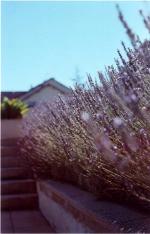|
Curtis Curtis Color Scout |
Fabriqué ou assemblé en Etats-Unis de (Antérieur à) 1939 à (Postérieur à) 1939.
Rareté en France : Rare (dans les vide-greniers non spécialisés)
N° inventaire : 30065
Fiche technique complète
Chronologie des appareils Curtis
Le Curtis reprend le principe de trichromie déjà utilisé par le Jos-Pe, dès les années 20, en Allemagne.
Ce type d'appareil reste très rare. Il permet la séparation des couleurs.
Il y a un seul objectif, mais le rayon lumineux va avoir un cheminement très particulier. Il va traverser deux miroirs semi-transparents. Sur le premier miroir, une partie du rayon ira éclairer par réflexion une surface sensible après avoir traversé un filtre coloré (rouge, bleu ou vert). Le filtre coloré ne laissera passer que la couleur lui correspondant.
Le rayon lumineux continue son chemin en traversant le premier miroir semi-transparent. Il arrive sur un second miroir (toujours en semi-transparent). Comme au premier miroir, une partie du rayon, par réflexion, puis traversée d'un filtre coloré (d'une couleur différente de la première fois) éclaire une surface sensible.
La partie du rayon qui traverse ce second miroir, traverse un filtre (d'une troisième couleur) et impressionne une troisième surface sensible. Du fait du retournement du rayon dans les miroirs, la troisième image sera symétriquement inversé dans la verticale par rapport aux deux premières.
Les trois surfaces sensibles sont une émulsion noir et blanc, elles ont donc des gris différents suivant le filtre coloré traversé par le rayon lumineux.
Une fois les trois surfaces impressionnées, il restait à effectuer le tirage couleur à partir des niveaux de gris.. Celui-ci était long, coûteux et certainement pas à la portée d'un amateur. Différents procédés permettaient la reconstitution des couleurs. Chez Curtis, il s'appelait le Orthotone.
Comme je ne trouve rien sur l'Orthotone, je reproduis ci-dessous un article extrait du Popular Photography de décembre 1938, présentant le principe du Chromatone, procédé proche de l'Orthotone, chez Defender.

Popular Photography 1939
Chromatone for color prints
 by A. H. LIVINGSTON
by A. H. LIVINGSTONDefender Photo Supply Co.
Here’s a simple method of making color prints. Transparent positives from the separattion negatives are toned and assembled in register on a mount.
A PHOTOGRAPH in natural color stil brings forth “ohs” and “ahs” when displayed, but no longer as a novelty creation. The beautiful print in the full colors of nature is a lasting tribute to the ever increasing perfection of photographic technique and to the ceaseless efforts of manufacturers to produce processes which will permit the photographer to portray his subjects as they actually appear.
Chromatone, a simple modern color print process, was introduced in 1935. Francis H. Snyder and Henry W. Rimbach, research scientists, sought as chemists and not as photographers, a method by which they could reproduce color in photomicrographic work. The toning methods and the formulas which these two men devised and the stripping film and its emulsion, developed by the Defender Photo Supply Company, combined to produce the Chromatone Process of today.
This color method has been accepted by many eminent photographers who are continually supplying national advertisers with the fascinating color illustrations which are currently appearing in popular magazines and other publications. The process, however, is not restricted solely to the commercial and professional fields, and should hold no terror for the amateur enthusiast. It is simple in technique and manipulation; excellent in results. It involves no generally new methods of processing. All of the treatments and manipulations involved are of a nature similar to those with which he h already familiar, namely, developing and toning. The Defender Chromatone Process is based on the principles which are fundamental to “two-color” and “three-color” photography.
No effort will be made in this article to discuss the scientifle aspects of color photography, but merely an attempt to explain the process sufficiently so that the reader, even if he has no knowledge of “three-color” theory, will be able to approach the making of color prints with a more complete understanding of the procedure.
It is no longer unusual for the amateur, to say nothing of the professional, to make three-color separation negatives with his regular camera and to produce from these a pleasing natural color photograph. The mysterious haze which heretofore has shrouded the making of separation negatives has been cleared through the publication of many articles and books on the subject. The booklet, “Methods of Making ThreeColor Separation Negatives,” published by the Defender Company is an excellent exposition of the many phases of preparing color-separation negatives.
Outine of Chrometone Process
All color processes depend upon and start with the three-color separation negatives. Starting with the three negatives taken respectively through blue, green, and red filters a balanced black-and-white positive is made from each on a special collodion stripping film (Chromatone Photo Print Paper) of a total thickness, when dry, of about onethousandth of an inch. These positive images are then toned in the special toners to yellow, magenta (blue-red), and blue-green. The three toned and stripped films are superimposed upon one another on a white paper base and allowed to dry. The result is a print in full natural color. It can be made without undue haste in one hour.
The finished Chromatone print, therefore, consists of three superimposed collodion-gelatin layers, toned respectively yellow, magenta, and blue-green. The print presents as its surface a durable collodion film which can easily be kept clean by wiping with a wet sponge if the print is not to be protected by glass.
Making fhe Black-and-Whife Positives
The first step in making prints by the Chromatone Process is the preparation of black-and-white images on Chromatone Print Paper from the three-color separation negatives. The color balance of the final print will depend upon the care employed in making the original black-and-white positives. The three prints, one from each negative, should be developed simultaneously in a deep dish with plenty of developer. Fixing is accomplished in the usual manner and it is in the fixing bath that the films can be stripped from the backing paper.
Following the foregoing procedure it has been found that this process has not been far out of the ordinary routine for black-and-white photography. The toning which follows is merely a mechanical operation and is the only deviation from the system to which all experienced workers are accustomed.
The second step and all the ensuing phases in the making of the Chromatone print may be carried on in white light. In fact, as soon as the black-and-white prints are fully fixed, white light may be admitted.
The stripped off black-and-white positive prints, intended for the red and blue images are placed in a tray and bleached in Red Toner A. After washing, the red image is placed in red Toner B and similarly, the blue image is placed in Blue Toner B. The yellow image is bleached and toned in the same manner using Yellow Toner A and Yellow Poner B. When the images are immersed in the different toning solution, the colors appear like magic.
The third step is the assembly of the toned positives to make the finished print.
 The registration of the three images in the final assembly is generally assumed to be difficult, but in reality it is accomplished very easily. When still wet, the images may be moved about at will and if they are not perfectly registered at first, it is possible to remove them, rewet them, and reassemble. This, of course, applies to the images before they have been squeegeed firmly into place and dried to any extent.
The registration of the three images in the final assembly is generally assumed to be difficult, but in reality it is accomplished very easily. When still wet, the images may be moved about at will and if they are not perfectly registered at first, it is possible to remove them, rewet them, and reassemble. This, of course, applies to the images before they have been squeegeed firmly into place and dried to any extent. The three images toned their respective colors are now registered on a gelatin-coated paper (Chromatone Backing Paper). The yellow image is placed on the wet paper and squeegeed into place. The magenta image, after a few minutes’ lapse, is placed on top of the yellow fixage, carefully registered and squeegeed firmly into position. A piece of blue cellophane placed over the light source at this stage aids greatly in effecting registration as the lines of the yellow image are very prominent when viewed in a blue light and it is a simple task to get perfect registration of the yellow and magenta positives.
After the yellow and magenta prints have been registered, the blue one, superimposed upon the other two, completes the assembly. The result, a print in full colors effectively reproducing the original subject, is positively startling when accomplished the first time. It is nearly as thrilling in each subsequent experience.
If the entire assembly is made with the collodion side up, the surface of the print has a high gloss. When assembled with the emulsion side up, Chromatone prints dry with a luster surface which is of higher gloss in the highlights than in the shadows. Variety may be given to the surface in many different ways. Pressing a piece of cloth (organdie) on the collodion surface while it is still wet will leave an imprint of the texture of the cloth and give a pleasing effect. It is also possible to assemble the print on fixed-out rough surfaced papers in place of the special backing paper. Other novel effects may be achieved through the rubbing of the surface with pumice stone or spraying with matte lacquer.
The cost of making a completed 5 x 7 Chromatone print amounts to approximately 74 cents but may be reduced considerably if the enthusiast uses a rubberset brush for brush-toning the prints rather than immersing them in a larger quantity of solution. Make sure, however, that the brush has no metal parts which are likely to mar the print.
The Defender Chromatone Process is not an involved and intricate system for producing a photograph in natural colors. Quite the contrary is true. Anyone who is painstaking and exercises precision in his work can turn out successful Chromatone photographs.


Liens extérieurs ou bibliographie :
| Principe de séparation des couleurs, proposé par Sylvain Halgand |
| Scott's Photographica collection, proposé par Sylvain Halgand |
Vos photos prises avec le même appareil :
Ajouter un lien extérieur donnant des informations intéressantes sur cet appareil ou un élément de bibliographie utilisé lors de la préparation de cette page, une photo prise avec le même appareil, une photo de boîte de ce modèle ou une ancienne publicité au sujet de ce modèle
Objets de même marque en vente sur Ebay France (Appareil photo Curtis) (Remis à jour toutes les 3 heures)







